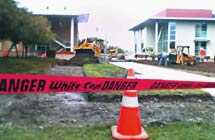
Handy Links
SLAC News Center
SLAC Today
- Subscribe
- Archives: Feb 2006-May 20, 2011
- Archives: May 23, 2011 and later
- Submit Feedback or Story Ideas
- About SLAC Today
SLAC News
Lab News
- Interactions
- Lightsources.org
- ILC NewsLine
- Int'l Science Grid This Week
- Fermilab Today
- Berkeley Lab News
- @brookhaven TODAY
- DOE Pulse
- CERN Courier
- DESY inForm
- US / LHC
SLAC Links
- Emergency
- Safety
- Policy Repository
- Site Entry Form

- Site Maps
- M & O Review
- Computing Status & Calendar
- SLAC Colloquium
- SLACspeak
- SLACspace
- SLAC Logo
- Café Menu
- Flea Market
- Web E-mail
- Marguerite Shuttle
- Discount Commuter Passes
-
Award Reporting Form
- SPIRES
- SciDoc
- Activity Groups
- Library
Stanford
Around the Bay
Please Be Alert to Caution Zones
 SLAC is a busy site, with many science and research projects going on at all times.
To support this research, we also have ongoing construction and maintenance projects to upgrade
existing structures and create new ones. The work zones are constantly shifting, so
precautions in the form of barricades, yellow or red tape, orange cones, and other methods
are used to alert people of hazards.
SLAC is a busy site, with many science and research projects going on at all times.
To support this research, we also have ongoing construction and maintenance projects to upgrade
existing structures and create new ones. The work zones are constantly shifting, so
precautions in the form of barricades, yellow or red tape, orange cones, and other methods
are used to alert people of hazards.
Recently, pedestrians and bicycle riders have crossed areas blocked with hazard tape, and in a couple of cases, even continued on when asked not to by safety personnel. The area near the new Kavli building has been particularly problematic as parts of the building have been opened for use, while the walkway near one of the entrances is still under construction. This is a dangerous situation. Please be aware of the hazards ongoing in these areas and heed construction signs.
Safeguards and Security at SLAC has issued a reminder that any areas at SLAC that are blocked off or marked with yellow caution tape or red danger tape should not be entered or crossed by any pedestrian or vehicular traffic.
The only persons authorized to enter the marked areas are the responsible workers and inspection personnel for the areas. If somebody not authorized goes through a marked area, Security will write violation notices of failure to follow this safety procedure and the notice will be sent to that person's supervisor, their Division Associate Director, and SLAC Human Resources.
Hazard markers around construction or maintenance zones are placed there for our safety, and they mean "stay out." There are many slip/trip fall hazards on a construction site, in addition to heavy equipment. What looks safe at first may have hidden and unexpected dangers. Safety should override the temporary inconvenience of having to take an alternate route.
Some safety suggestions to avoid hazards are:
- Allow yourself enough time to get somewhere—if you're rushing to a meeting, you might be tempted to take shortcuts over hazard zones.
- Think of alternate routes—if one area to a building is blocked, remember that there are always other entrances that can be used.
- Obey cautions from people in the area—if somebody alerts you to a hazard zone, please don't ignore them.
- Don't assume that just because an area looks safe, it is—hazard markers are never placed in an area for no reason; the dangers might be hidden or just around the corner.
- Assume a safety radius—if a cone has been tipped over, or a tape torn out of position, assume that anything around it might be the hazard zone and avoid the whole area until somebody can fix the markers.
- Ask if you're not sure—construction areas have people responsible for them, check with them if you'd like to know more about the hazard zone.
Remember—the hazard warnings are there for our sake. Be alert to cautions, and we'll keep ourselves safe.
For more information about safety at SLAC, please see the Environment, Safety, and Health website and the Safeguards and Security website.
—Larissa Williams
SLAC Today, March 23, 2006